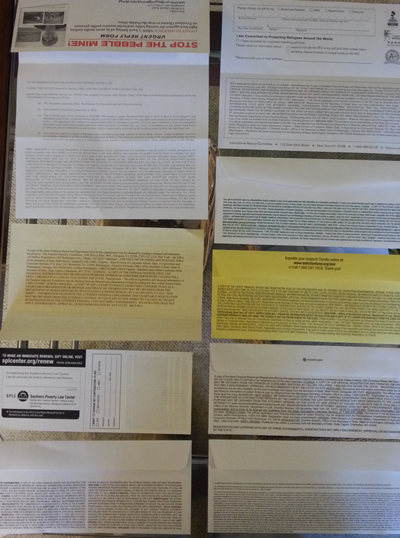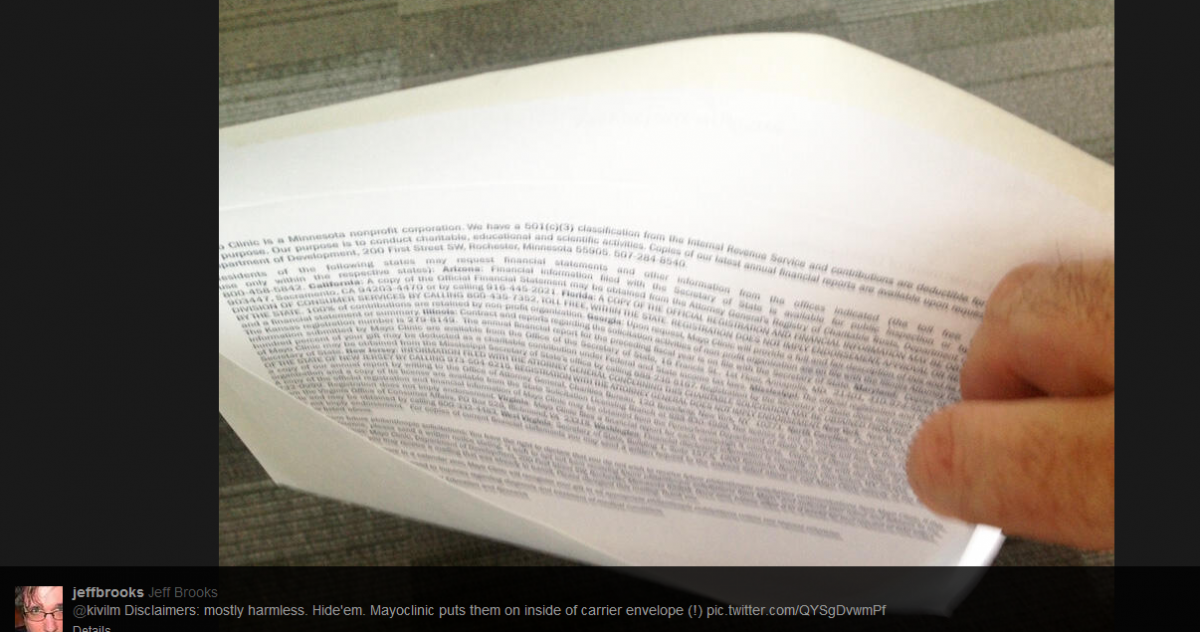I received a question this week about all of that state-by-state fundraising solicitation disclosure language and how that should be included within a fundraising direct mail package.
This language is hideous, naturally, from a communications perspective. It’s our equivalent of those pages of fine print that no one reads on the back of our credit card statements. It’s full of jargon and ends up being one nasty list of legalese, state by state.
In my thank-you letter webinars, I recommend that nonprofits who must include the IRS disclosure language as part of the donation receipt (the “no goods or services” language for gifts over $75) put it in a separate box at the bottom of the thank you letter, after a P.S., entirely outside the main body of the letter, so that the prose speaks personally and directly to the donor. All that regulatory language has a way of interfering with the positive feelings you are sharing in a well-written thank you letter. Your thank you letter should be primarily to the inner angel, rather than the inner bookkeeper.
The same applies with this solicitation legalese in direct mail appeals. Where do you put it so that you comply with the rules, but so that it doesn’t get in the way of your communication with your supporter? That’s my interest . . . My expertise is in nonprofit marketing communications, not the law.
I did a completely non-scientific review by looking in my recycle bin. I pulled out the last 10 solicitations received in the last week or so from national nonprofits. One didn’t include the language anywhere in the package at all. Five put it on the back of the return envelope. Four put it on the back of the reply device itself or on the back of the paper that included a tear-off reply device.

Mind you, this is what I see people doing, but I have no idea if any of this has actually been tested in any way to see if where you put it affects the return. I couldn’t find anything online about which works best or how to handle it at all. So I tweeted two smart people who I knew would have some answers.
Tony Martignetti is an expert on charity registration and the host of Nonprofit Radio. Here’s what Tony said:

And look what Jeff Brooks, a direct mail fundraising specialist, favorite blogger, and author of The Fundraiser’s Guide to Irresistible Communications shared:

In case you can’t read Jeff’s tweet, it says that the Mayo Clinic hides the disclosures on the inside of the carrier envelope! Now that’s some creative thinking.
I personally think it looks terrible on the outside of the reply envelope, which is what half of the groups in my little sample above are doing. That envelope is, they hope, something that I will personally put a stamp and my return address on and put in my mail box. And yet it seems to scream, “Beware! You are mailing something dangerous! So much so that it requires all of these disclosures right smack on this envelope for the world to see!” Feels strange, and uncomfortable — but that’s just me. I admit that at age 43 I am not yet in the prime direct mail target audience. Maybe people over 65 don’t care about that.
Anyway, the Mayo Clinic’s inside the carrier envelope example notwithstanding, from a communications perspective, I would go with the back of one of the pieces of the letter, probably the last page, so it doesn’t interrupt the real message.
In terms of what this language should actually say, the best resource I found online was from Perlman and Perlman. They have a state by state listing of disclosure requirements along with some sample language (although the copyright says 2012, so I don’t know if anything changed for 2013).
What do you think? How do you comply with the law without all the legalese mucking up your messaging? Know of any data on whether it matters where you put it?





